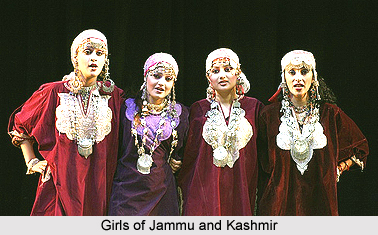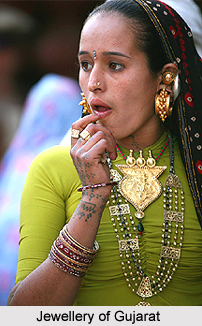 Traditional Indian Jewellery is the long drawn saga of Indian Tradition that is so exquisitely brought out by the maintenance of the on going traditional strain. The Traditional Jewellery of India is of varied types and numerous forms.
Traditional Indian Jewellery is the long drawn saga of Indian Tradition that is so exquisitely brought out by the maintenance of the on going traditional strain. The Traditional Jewellery of India is of varied types and numerous forms.
Meenakari Jewellery
Meenakari Jewellery is the exuberant exemplification of Meenakari Art; an ancient form of art in India that has been praised since its introduction for the superb designs and combination of colours. From the prime age of this craft, the artisans were named as `meenakar` who were involved in creating different Meenakari items. In some work, the entire object, such as pendant, is covered with this exclusive technique. On a typical pair of `kara` bangles with three-dimensional `makara`, elephant, lion or bird head terminals, additionally decorated with diamonds, rubies, and emeralds, as they often were, is a dazzlingly opulent object that embodies a galaxy of goldsmith arts.
Stone Jewellery
Stone Jewellery is another form of jewelry that is studded with different gems and from times immemorial it has been a popular one in the domain of Indian Jewellery. Several reasons ranging from spiritual to aesthetic to health, has been a reason for the evolution and popularity of the gemstone jewelry which thrives to be an integral part of Indian Jewellery which has become the part of life of Indian women and men both. These stone jewelries are worn according to the individual`s astrological chart and ruling of planet.
 Gold Jewellery
Gold Jewellery
Gold Jewellery bears the testimony of rich Indian Tradition. Gold is one of the valued metals in all over the world and gold jewellery in India has occupied a major position for its antiquity of use and fame. Even gold is used as the base metal for creating different jewelleries since the ancient times as many evidences are found in Harappa and Mohenjodaro. Gold was reckoned as `tears of the Sun` and gold was the only metal ore which had been found by the mankind. Also it was said to be the most valuable among all metals. Apart from these, Thousands of common, everyday appliances require `Gold` to ensure perfect performance over a long period of time. This indestructible metal is completely recyclable and virtually immune to the effects of air, water, and oxygen. Gold jewelleries have been in demand since the primordial age, when mankind learned to use the metal. The use of gold with gem and other stones was started before a thousand years and this past tradition has introduced the trend of using diamond in gold jewelleries and this is one of the most sought after combinations. Earlier kings and queens patronized the gold jewelleries most of which were elaborate gold jewelleries and crowns studded with diamonds. Even now Gold Jewellery is the name that counts when families think about marriage.
Bead Jewellery
Bead Jewellery or Bead art in India dates back to a history of five thousand year when Indus Valley Civilization had been the existing Civilization of India. The populace pertaining to that civilization manufactured beads out of gold, silver, copper, clay, ivory and even wood. The excavations which were carried out there arrived with finished and unfinished beads from the site. After looking onto them, one gets amazed at the wonderful sense of bead work and jewelry at that time. India is amongst the largest producers of glass beads and particularly, the beads produced in Varanasi are exported in large quantities.
 As the Mughal reigned and gave enough patronage to the bead jewelry they were in vogue. Bead necklaces of different size and shapes, made up of precious and semi-precious stones, were quite popular during that time. With the passage of time as Europeans arrived in India, the bead work became more obvious and semi-transparent. Europeans looked for better and refined as well as transparent bead work, which enabled the artisans to develop their art up to the optimum. This led to widening of the horizon of bead jewelry making.
As the Mughal reigned and gave enough patronage to the bead jewelry they were in vogue. Bead necklaces of different size and shapes, made up of precious and semi-precious stones, were quite popular during that time. With the passage of time as Europeans arrived in India, the bead work became more obvious and semi-transparent. Europeans looked for better and refined as well as transparent bead work, which enabled the artisans to develop their art up to the optimum. This led to widening of the horizon of bead jewelry making.
Terracotta Jewellery
Terracotta jewelleries are one of the most available and ancient form of art that has its demand in recent times as well. The aroma of cooking earth and making it red hard involves the making of Terracotta Jewellery. After the earth is cooked, the items are coloured in different tints to give a perfect sheen. In recent times, terracotta jewellery like chokers, bracelets, pendants, necklaces, create a different look if worn with either traditional or tribal dresses. The traditional shapes ranges from the tribal gods, Hindu Gods like Lord Ganesha, Hanuman, et al, animals or sometimes abstract art is made to give them a contemporary and modern look.
 Indian Tribal Jewellery
Indian Tribal Jewellery
Indian Tribal Jewellery reinstates the spirit, the form, the essence of India, the earthen India that placed ethnicity to a larger and elevated platform. As modern era approached and the fever of globalization spread like epidemic, it was the tribal India who had preserved the ancient crafts and arts of India. One such form of ethnic Indian art was the jewellery used by the tribes. Ornaments used by the tribes stand out in a crowd because of its rustic and earthy flavour. They make jewellery from the indigenous items that are available locally. Moreover the jewellery they prepare exhibit their artistic skill in a profound manner. Rather it can be said that the appeal of the tribal jewellery is mainly due to its chunky and unrefined look.
Bridal Jewellery
Bridal Jewellery thrives to be one of the most significant elements in Indian weddings and even adds to the bandwagon of the Traditional Indian Jewellery. Bridal jewellery basically helps in completing the attire and overall look of an Indian bride. Bridal jewellery is of different types. It includes attractive necklace set, pendant set, rings, bracelets, bangles, or earrings and more. In fact, it is very true that bridal jewellery happens to be one of the integral parts of Indian wedding. Generally, bridal jewelleries are made of gold, silver, diamond, kundan and even platinum.
Temple Jewellery
Temple Jewellery bears the testimony of religiosity of the ancient times and the associated jewel tale of the deities. Temple Jewellery in South India has a timeless camaraderie with the land itself. Tradition has its roots deep delved into the soils of South India and as obvious result temple jewellery is of paramount vitality in the Dravidian land and even the foreign invasion could not cater any significant amount of loss of them. Most of this jewellery was donated by the people to adorn the deities of the temples.



















